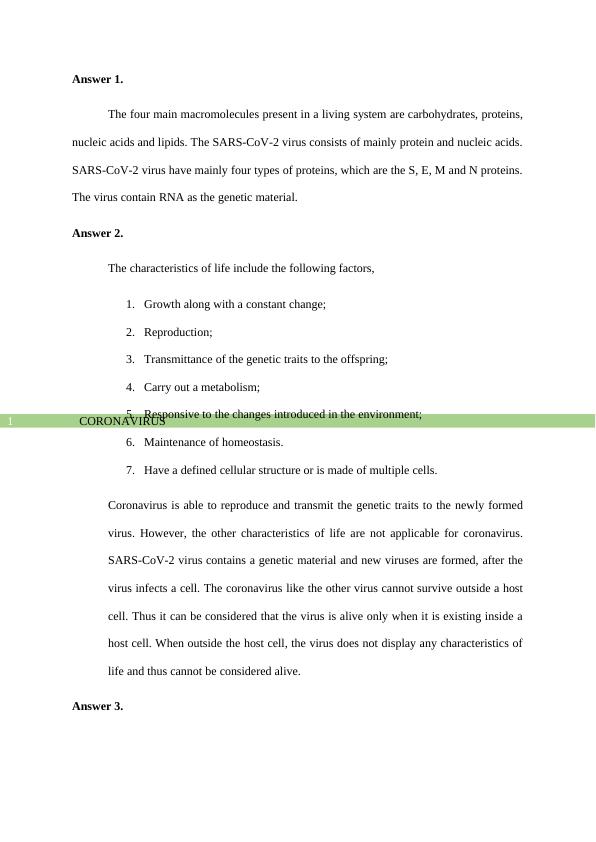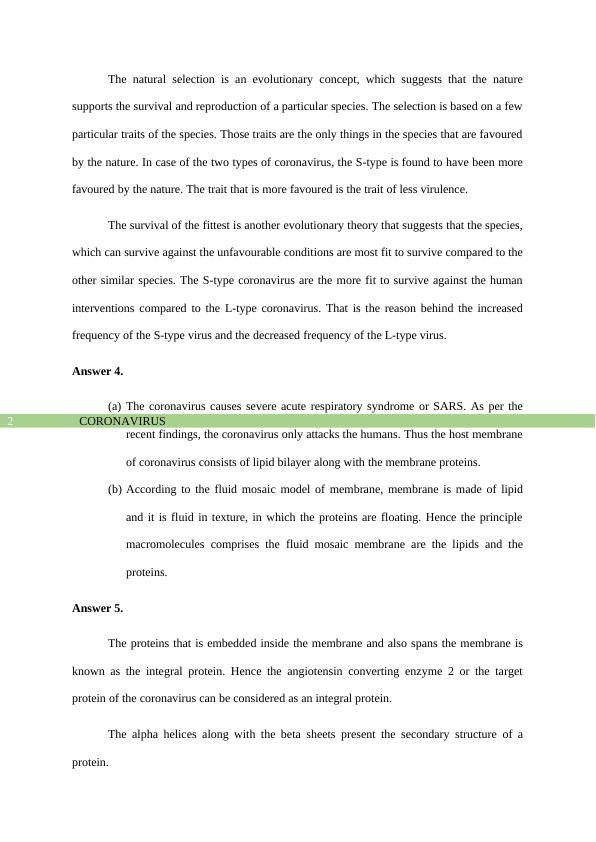Macromolecules Present in a Living System
Discussing the structure and characteristics of SARS-CoV-2 and explaining the findings of the two main strains.
6 Pages1378 Words76 Views
Added on 2022-08-21
Macromolecules Present in a Living System
Discussing the structure and characteristics of SARS-CoV-2 and explaining the findings of the two main strains.
Added on 2022-08-21
ShareRelated Documents
Running head: CORONAVIRUS
CELL BIOLOGY: CORONAVIRUS
Name of the Student:
Name of the University:
Author Note:
CELL BIOLOGY: CORONAVIRUS
Name of the Student:
Name of the University:
Author Note:

CORONAVIRUS1
Answer 1.
The four main macromolecules present in a living system are carbohydrates, proteins,
nucleic acids and lipids. The SARS-CoV-2 virus consists of mainly protein and nucleic acids.
SARS-CoV-2 virus have mainly four types of proteins, which are the S, E, M and N proteins.
The virus contain RNA as the genetic material.
Answer 2.
The characteristics of life include the following factors,
1. Growth along with a constant change;
2. Reproduction;
3. Transmittance of the genetic traits to the offspring;
4. Carry out a metabolism;
5. Responsive to the changes introduced in the environment;
6. Maintenance of homeostasis.
7. Have a defined cellular structure or is made of multiple cells.
Coronavirus is able to reproduce and transmit the genetic traits to the newly formed
virus. However, the other characteristics of life are not applicable for coronavirus.
SARS-CoV-2 virus contains a genetic material and new viruses are formed, after the
virus infects a cell. The coronavirus like the other virus cannot survive outside a host
cell. Thus it can be considered that the virus is alive only when it is existing inside a
host cell. When outside the host cell, the virus does not display any characteristics of
life and thus cannot be considered alive.
Answer 3.
Answer 1.
The four main macromolecules present in a living system are carbohydrates, proteins,
nucleic acids and lipids. The SARS-CoV-2 virus consists of mainly protein and nucleic acids.
SARS-CoV-2 virus have mainly four types of proteins, which are the S, E, M and N proteins.
The virus contain RNA as the genetic material.
Answer 2.
The characteristics of life include the following factors,
1. Growth along with a constant change;
2. Reproduction;
3. Transmittance of the genetic traits to the offspring;
4. Carry out a metabolism;
5. Responsive to the changes introduced in the environment;
6. Maintenance of homeostasis.
7. Have a defined cellular structure or is made of multiple cells.
Coronavirus is able to reproduce and transmit the genetic traits to the newly formed
virus. However, the other characteristics of life are not applicable for coronavirus.
SARS-CoV-2 virus contains a genetic material and new viruses are formed, after the
virus infects a cell. The coronavirus like the other virus cannot survive outside a host
cell. Thus it can be considered that the virus is alive only when it is existing inside a
host cell. When outside the host cell, the virus does not display any characteristics of
life and thus cannot be considered alive.
Answer 3.

CORONAVIRUS2
The natural selection is an evolutionary concept, which suggests that the nature
supports the survival and reproduction of a particular species. The selection is based on a few
particular traits of the species. Those traits are the only things in the species that are favoured
by the nature. In case of the two types of coronavirus, the S-type is found to have been more
favoured by the nature. The trait that is more favoured is the trait of less virulence.
The survival of the fittest is another evolutionary theory that suggests that the species,
which can survive against the unfavourable conditions are most fit to survive compared to the
other similar species. The S-type coronavirus are the more fit to survive against the human
interventions compared to the L-type coronavirus. That is the reason behind the increased
frequency of the S-type virus and the decreased frequency of the L-type virus.
Answer 4.
(a) The coronavirus causes severe acute respiratory syndrome or SARS. As per the
recent findings, the coronavirus only attacks the humans. Thus the host membrane
of coronavirus consists of lipid bilayer along with the membrane proteins.
(b) According to the fluid mosaic model of membrane, membrane is made of lipid
and it is fluid in texture, in which the proteins are floating. Hence the principle
macromolecules comprises the fluid mosaic membrane are the lipids and the
proteins.
Answer 5.
The proteins that is embedded inside the membrane and also spans the membrane is
known as the integral protein. Hence the angiotensin converting enzyme 2 or the target
protein of the coronavirus can be considered as an integral protein.
The alpha helices along with the beta sheets present the secondary structure of a
protein.
The natural selection is an evolutionary concept, which suggests that the nature
supports the survival and reproduction of a particular species. The selection is based on a few
particular traits of the species. Those traits are the only things in the species that are favoured
by the nature. In case of the two types of coronavirus, the S-type is found to have been more
favoured by the nature. The trait that is more favoured is the trait of less virulence.
The survival of the fittest is another evolutionary theory that suggests that the species,
which can survive against the unfavourable conditions are most fit to survive compared to the
other similar species. The S-type coronavirus are the more fit to survive against the human
interventions compared to the L-type coronavirus. That is the reason behind the increased
frequency of the S-type virus and the decreased frequency of the L-type virus.
Answer 4.
(a) The coronavirus causes severe acute respiratory syndrome or SARS. As per the
recent findings, the coronavirus only attacks the humans. Thus the host membrane
of coronavirus consists of lipid bilayer along with the membrane proteins.
(b) According to the fluid mosaic model of membrane, membrane is made of lipid
and it is fluid in texture, in which the proteins are floating. Hence the principle
macromolecules comprises the fluid mosaic membrane are the lipids and the
proteins.
Answer 5.
The proteins that is embedded inside the membrane and also spans the membrane is
known as the integral protein. Hence the angiotensin converting enzyme 2 or the target
protein of the coronavirus can be considered as an integral protein.
The alpha helices along with the beta sheets present the secondary structure of a
protein.

End of preview
Want to access all the pages? Upload your documents or become a member.
